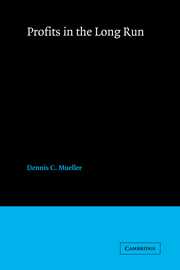Book contents
- Frontmatter
- Contents
- Acknowledgments
- 1 The persistence of firms
- 2 The persistence of profits above the norm
- 3 The persistence of market power
- 4 Profitability and market structure
- 5 The results in perspective
- 6 Profitability and the firm's own advertising, patent activity, risk, and other characteristics
- 7 Profitability and managerial control and compensation
- 8 Mergers and profitability
- 9 Mergers and market share
- 10 The threads gathered and conclusions woven
- Appendix 1 Companies studied
- Appendix 2 Industry categories
- Appendix 3 Industry matchings
- Appendix 4 Assets acquired data (Chapter 7)
- Appendix 5 Mergers and market share: samples of merging companies
- Notes
- References
- Index
10 - The threads gathered and conclusions woven
Published online by Cambridge University Press: 04 May 2010
- Frontmatter
- Contents
- Acknowledgments
- 1 The persistence of firms
- 2 The persistence of profits above the norm
- 3 The persistence of market power
- 4 Profitability and market structure
- 5 The results in perspective
- 6 Profitability and the firm's own advertising, patent activity, risk, and other characteristics
- 7 Profitability and managerial control and compensation
- 8 Mergers and profitability
- 9 Mergers and market share
- 10 The threads gathered and conclusions woven
- Appendix 1 Companies studied
- Appendix 2 Industry categories
- Appendix 3 Industry matchings
- Appendix 4 Assets acquired data (Chapter 7)
- Appendix 5 Mergers and market share: samples of merging companies
- Notes
- References
- Index
Summary
In this chapter we pull together the various strands running through the preceding chapters, relate them to previous research on profitability, and draw policy implications. Section A combines the variables from the preceding chapters that have proven to be important determinants of long-run profits into a single model. In Section B some of the implications of the results for the structure-performance literature are drawn. Implications for future research and policy are discussed in Sections C and D.
The complete model
In Chapter 6 we examined the effects of several firm-specific characteristics on projected profitability: advertising, patent intensity, risk, sales, diversification, and growth. Neither the firm's own advertising nor its patent intensity had a significant impact on its projected profitability. The covariance (β) measures of risk both had significant coefficients but of the wrong sign, if it is hypothesized that abovenormal profits persist because of the existence of above-normal risks. We conjectured that reverse causality was involved. Firms with persistently high profits were perceived by the stock market to be less risky investments, that is, less subject to the systematic risks prevailing in the economy. Given the likelihood that reverse causality was involved n the (β-αrelationship, we did not include either (β-type risk easure in the completed model.
- Type
- Chapter
- Information
- Profits in the Long Run , pp. 209 - 233Publisher: Cambridge University PressPrint publication year: 1986

